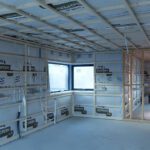Modern homes and buildings are achieving greater levels air tightness with and have requirements for substantial levels of insulation. This dramatically affects how the building performs from a humidity, moisture management and fresh air point of view. The number of studies carried out on existing buildings are limited but generally conclusive. Natural ventilation can be demonstrated to comply from a regulatory point of view but real life testing conflicts.
There are many ventilation options on the market at the moment from centralised to decentralised heat recovery to demand controlled, positive pressure ventilation, passive stack ventilation, natural ventilation, trickle vents and purge ventilation. Studies tend to prove that without adequate mechanical ventilation in the appropriate locations it can lead to moisture build up and condensation issues. This follows on to mould growth and poor indoor air quality.
In renovation projects increased insulation in walls and roofs is called for to increase building performance. If naturally follows that airtightness is improved in upgrades. Prior to the renovation the ‘leaky’ building fabric provides enough unplanned fresh air to maintain air quality – comfort and heating costs are sacrificed in this scenario. The safe solution is, to install an adequate mechanical ventilation system that best suits you and your house. These could be any of the options below
- MEV – Mechanical Extract Ventilation. Manually controlled Extracts to wetrooms and fresh air supplies to living rooms – LUNOS Silvento ec + ALDR
- DMEV –Time, Temperature and humidity controlled Extract Ventilation controlled Extracts to wetrooms and fresh air supplies to living rooms – LUNOS Silvento FK + ALDR
- Hybrid Systems- Timed Extracts to wetrooms and Heat recovery to living rooms – LUNOS Silvento ec + E2 +Nexxt
- MVHR Systems Timed Extracts to wetrooms and Heat recovery to living rooms – LUNOS EGO + E2 + Nexxt
Some relevant topics that need to be noted and discussed when choosing a ventilation system are not only the cost.
- SFP specific fan power or energy consumption, this can fluctuate depending on the system
- CE marking- have they been tested and references of where they have been used?
- Noise level or db level and at what distance is that measured away from the fan. LUNOS measure at 1m, where most supplies measure at 3m.
- Pressure difference. Is it capable of maintain the extraction rate regardless of external conditions or meeting the air extract demand of a dwelling eg. Wind, exposed area, coastal region. LUNOS radial fans are superb in this area.
- Warranty with the system, are parts easily replaced if something breaks
- How often do filters need to be changed or cleaned
- Efficiency of the system
- If it is a heat recovery system how much heat does it recover summer ventilation mode
- Can the system be upgraded
The following study ”Evaluation of the Impact of Retrofitting a Mid-terrace 1950’s House in Dublin on Indoor Air Quality” in 2010 *concludes in a monitored test environment that good indoor air quality is not assured when complying with building regulations through the input of intermittent vents and fresh air supplies. .
Natural ventilation is flawed for many reasons but the uncontrolled fresh air supply on cold days or exposed houses often mean that said vents are blocked. The actual extract would normally create the demand for fresh air intakes but if the extract fans are not running constantly at a minimum speed fresh air will not be maintained.
Lunos have three main types of system solutions,
LUNOS- Demand Controlled Ventilation system or decentralised MEV as it is noted under the SEAI DEAP software. This performs very well in practice and in DEAP software. The SFP is only 0.35 W/l/s for the RA 15-60 . This is a cost effective solution which can be upgraded to heat recovery in the future as it also uses the LUNOS 160 series sleeves. Air supply is attenuated for sound, air flow and is also filtered. The sound difference from inside to outside is quite high of 55db. Filters are of a high grate G2 filter class which can be washed dried and reused. The system is uncomplicated to install as air supply vents are non mechanical while extractor fans in the wet areas can be wall or ceiling mounted, humidity sensors can controls the speed of the fan boosting or slowing the fan depending on the humidity in the air.
Lunos – MVHR decentralised mechanical ventilation with heat recovery has one of the highest heat recovery efficiency on the market has an average heat recovery of 90.6% for the e2 and incredibly low SFP generally but the lowest reading is for the LUNOS e2neo model with 0.54W/l/s. There are three types of fan units for the Lunos MVHR system – e2 Nexxt and ego. The e2 is for all the habitable rooms and the ego are used for all the wet rooms, The Nexxt unit is larger and can ventilate large areas. E2 operate in pairs they are made up of a honey comb designed ceramic core element making up the majority of the unit, internally the unit has a fan which alternates direction from extract to supply every 70 seconds. While the fan operating in extract the hot air is charging the ceramic core heating the unit and then after 70 seconds the fan changes direct and supplies fresh air. While the new fresh air is passed though this now heated ceramic core element it heats up and ventilates through the house.
Lunos – Hybrid decentralised heat recovery ventilation incorporates both types of Lunos systems together MVHR and DCV. This is system would have an approximate efficiency of >80%. It consists of e2 units in all the habitable areas and extractor fans on timer delay modules in the wet areas. The extractor fans would be wired to operate to come on every 4hr for 15mins and can be manually operated also. The majority of the ventilation would be by the e2 units.
* Source – ”Evaluation of the Impact of Retrofitting a Mid-terrace 1950’s House in Dublin on Indoor Air Quality” by Aereco









